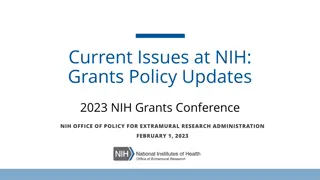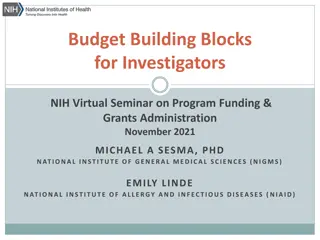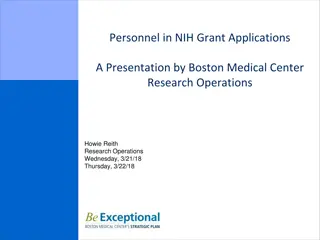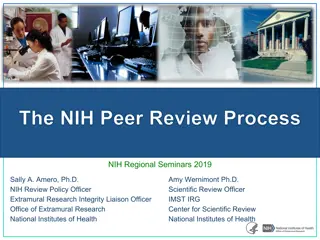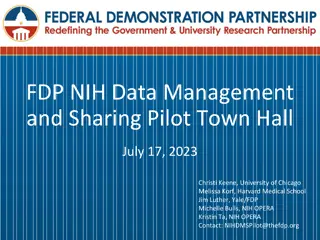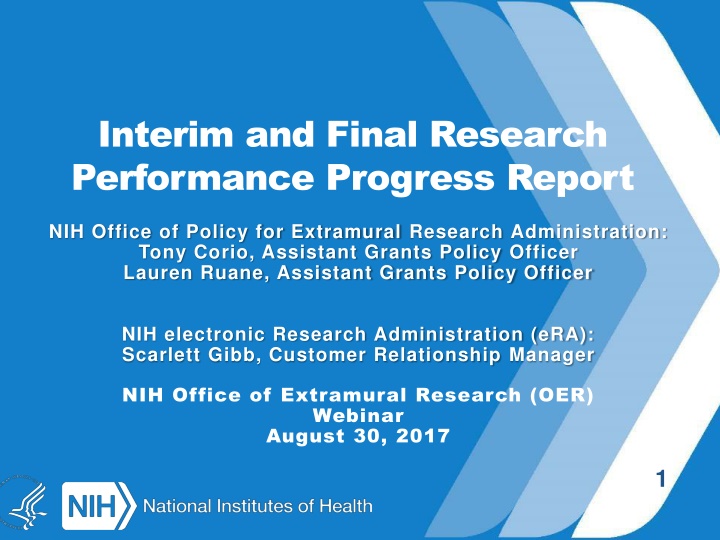
Federal RPPR Implementation and Progress Report Overview
This report provides an overview of the Federal-wide Research Performance Progress Report (RPPR) and its impact on the recipient community. It discusses the background, policy changes, and recent developments in implementing the RPPR across federal agencies, focusing on standardization, consistency, and reduced burden for recipients. The report also highlights the initial NIH implementation of the RPPR and upcoming changes in the electronic Research Administration (eRA) system.
Download Presentation

Please find below an Image/Link to download the presentation.
The content on the website is provided AS IS for your information and personal use only. It may not be sold, licensed, or shared on other websites without obtaining consent from the author. If you encounter any issues during the download, it is possible that the publisher has removed the file from their server.
You are allowed to download the files provided on this website for personal or commercial use, subject to the condition that they are used lawfully. All files are the property of their respective owners.
The content on the website is provided AS IS for your information and personal use only. It may not be sold, licensed, or shared on other websites without obtaining consent from the author.
E N D
Presentation Transcript
Interim and Final Research Performance Progress Report NIH Office of Policy for Extramural Research Administration: Tony Corio, Assistant Grants Policy Officer Lauren Ruane, Assistant Grants Policy Officer NIH electronic Research Administration (eRA): Scarlett Gibb, Customer Relationship Manager NIH Office of Extramural Research (OER) Webinar August 30, 2017 1
Outline Background on the Federal-wide RPPR Initial Implementation Policy Changes Impact on Recipient Community Accessing and Submitting the Interim and Final RPPR Upcoming eRA Changes 2
BACKGROUND ON THE FEDERAL-WIDE RPPR 3
RPPR Background National Science and Technology Council (NSTC) Committee on Science (CoS) Research Business Models (RBM) Subcommittee initiative to: Create greater administrative consistency across federal agencies Provide a consistent reporting format for interim progress reports Decrease burden on recipients by standardizing reporting elements across federal agencies Make it easier to compare the outputs, outcomes of research programs across the government 4
INITIAL IMPLEMENTATION 5
Initial NIH Implementation NIH introduced the RPPR in October 2012, based on a policy memorandum from OMB and NSTC. RPPR replaced previous interim performance reporting formats used by NIH and other agencies Used for annual progress reporting Use of RPPR became mandatory for all type 5 progress reports on October 17, 2014 6
Recent Fed-wide Developments In order to keep its promise, the RBM expanded the original charge and asked NSF and NIH to continue to serve as co-chairs of a workgroup tasked with incorporating lessons learned by agencies during the initial implementation to develop a standard format for use in reporting final progress. Participating agencies included: NIH (co-Chair) NSF (co-chair) Department of Agriculture: NIFA Department of Commerce: NIST/NOAA Department of Defense Department of Education Department of Energy Department of Homeland Security Department of Justice Environmental Protection Agency (EPA) NASA National Endowment of the Humanities 7
Recent Fed-wide Developments (Cont d.) This interagency workgroup completed its task and on November 16, 2016, published a Federal Register notice announcing the updated standardized RPPR to be used for final performance progress reporting. 8
NIH Closeout Requirements NIH Recipients Must Submit 3 Final Reports within 120 days of the project period end date: 1. Final RPPR 2. Final Federal Financial Report 3. Final Invention Statement As of January 2017, NIH replaced the Final Progress Report (FPR) with the Final RPPR to satisfy grant closeout requirements. 9
Differences Between the Annual RPPR vs. Final RPPR NIH Annual RPPR NIH Final RPPR A. B. C. D. Cover Page Accomplishments Products Participants and Other Collaborators Impact SBIR/STTR only Changes Special Reporting Requirements Budget Project Outcomes A. Cover Page B. Accomplishments C. Products D. Participants E. F. G. E. Impact F. Changes G. Special Reporting Requirements H. I. H. Budget 10
Project Outcomes Requirements A new section of the RPPR specifically designed to be made publicly available by the agency (analogous to the abstract in the competing application) Reporting in the Outcomes section is limited (by the federal-wide RPPR format) to 8,000 characters The Outcomes should provide a concise summary of the findings of the award written in lay language for the general public In an effort to increase transparency NIH will make the Outcomes data available in RePORTER 11
Whats Going Away and Why? Previous NIH Policy: NIH Grants Policy Statement Section 8.6.2 Final Progress Report: If a competitive renewal (Type 2) application has been submitted, whether funded or not, the progress report contained in that application may serve in lieu of a separate final progress report. Limitations and Challenges: Must use RPPR format for all performance reporting based on NSTC/CoS/RBM Federalwide policy otherwise NIH s final performance reporting requirement is misaligned with the requirements of other Federal research awarding agencies. Missed opportunity for structured data collection on last year of competitive segment without a change. 13
Whats New for Type 2s: The Interim Research Performance Progress Reports (I-RPPR) Effective February 9, 2017, NIH requires that organizations submit an Interim- RPPR while their renewal application (Type 2) is under consideration In the event that the Type 2 is funded, NIH will treat the Interim-RPPR as the annual performance report for the final year of the previous competitive segment If the Type 2 is not funded, NIH will treat the Interim-RPPR as the institution s Final-RPPR Like the Final-RPPR, recipients are required to report on Project outcomes in the Interim-RPPR. To reduce burden NIH will not require recipients to submit an additional Final-RPPR if the renewal application is not funded NOT-OD-17-037 See NOT-OD-17-037 for additional information. 14
Workflow Process NIH requires recipients to report on Project Outcomes in Section I of the Interim and Final-RPPR. Therefore, in each scenario listed above, Project Outcomes must be provided by the recipient in order for the recipient to submit their final report in eRA Commons. Otherwise, eRA Commons will not allow recipients to submit the required report and recipients will be considered non-compliant. 15 If a recipient fails to comply with this reporting requirement, NIH may take one or more enforcement actions, such as a decision to withhold a non- competing continuation award, consistent with NIHGPS Chapter 8.5.2.
NIH Implementation of the F-RPPR for Small Business and Innovation Research (SBIR) and Small Business Technology Transfer (STTR) Grants and Cooperative Agreements Effective June 30, 2017, all SBIR/STTR Phase II final reports must be submitted using the F-RPPR. The renewal policy has also been discontinued for SBIR/STTRs For Phase I or Phase II SBIR/STTR grants and cooperative agreements, this means that an I-RPPR is required if an application for a Phase II or Phase IIB has been submitted In the event that the Type 2/Phase II/IIB application is funded, NIH will treat the Interim-RPPR as the annual performance report for the final year of the previous competitive segment. If the Type 2 is not funded, the Interim-RPPR will be treated by NIH staff as the institution's Final-RPPR. 16 See NOT-OD-17-085 for additional information.
Workflow Process SBIR/STTR Status of Phase II/IIB Application following Phase I/II Award Scenario Workflow Process Submit a Final-RPPR no later than 120 calendar days from the Phase I/II period of performance end date. Not submitted 1 Submit an Interim-RPPR no later than 120 calendar days from the period of performance end date. If the Phase II/IIB is funded, NIH will treat the Interim-RPPR as the annual performance report for the final year of the previous competitive segment. Submitted 2 Submit an Interim-RPPR no later than 120 calendar days from the period of performance end date. If the Phase II/IIB is not funded, NIH will treat the Interim-RPPR as the institution's Final-RPPR. To reduce burden NIH will not require recipients to submit an additional Final-RPPR if the renewal application is not funded. Submitted but not funded 3 NIH requires recipients to report on Project Outcomes in Section I of the Interim and Final-RPPR. Therefore, in each scenario listed above, Project Outcomes must be provided by the recipient in order for the recipient to submit their final report in eRA Commons. Otherwise, eRA Commons will not allow recipients to submit the required report and recipients will be considered non-compliant. 17 If a recipient fails to comply with this reporting requirement, NIH may take one or more enforcement actions, such as a decision to withhold a non- competing continuation award, consistent with NIHGPS Chapter 8.5.2.
SBIR/STTR ONLY Added Section E.3.a - Describe Sales Revenue Added Section E.3.b Describe the Regulator Approval Status Added Section G.4.d - Status of Clinical Trials for Your Product Added Section G.13.a - Describe Company Outcomes Added Section G.13.b - Reimbursement Approval Status 18
NIH Implementation - RPPRs As of February 9th, 2017, there are three types of RPPRs, each one is outlined in the NIH RPPR Instruction Guide. Annual RPPR Use to describe a grant s scientific progress, identify significant changes, report on personnel, and describe plans for the subsequent budget period or year. Interim RPPR Use when submitting a renewal (Type 2) application. If the Type 2 is not funded, the Interim RPPR will serve as the Final RPPR for the project. If the Type 2 is funded, the Interim RPPR will serve as the annual RPPR for the final year of the previous competitive segment. The data elements collected on the Interim RPPR are the same as for the Final RPPR, including project outcomes. Final RPPR Use as part of the grant closeout process to submit project outcomes in addition to the information submitted on the annual RPPR, except budget and plans for the upcoming year. 19
IMPACT ON THE RECIPIENT COMMUNITY 20
How Do These Changes Impact the Recipient Community? Reporting on project outcomes is a new requirement Failure to report on project outcomes may result in remedies for non- compliance, which may result in enforcement actions by the IC Recipient s should ensure that project outcomes are written in concise lay language, which can be understandable to the general public. Once submitted for review to the NIH, the accuracy and completeness of all elements (including project outcomes) of the I-RPPR and F- RPPR is the responsibility of the assigned PO Additional materials and/or clarifying information will be requested and submitted using the Final Report Additional Materials (FRAM) 21
FRAM Module 22
RPPR FAQs FAQs: https://grants.nih.gov/grants/rppr/faqs.htm Section D.1 Individuals who worked on the project: Should this section report on individuals/staff from the past year of the project or the whole project? This section should report on the individuals/staff that worked on the project during the last budget period minus any approved no-cost extensions. Where can recipients find instructions on how to submit the Final or Interim-RPPR? Information on submitting a Final or Interim-RPPR can be found in the RPPR Instruction Guide or on the eRA Online Help website. 23
RPPR FAQs (cont.) FAQs: https://grants.nih.gov/grants/rppr/faqs.htm Will the information reported under Project Outcomes be made public? Yes. The information submitted in this section will be accessible to the general public via NIH's Research Portfolio On-line Reporting Tools (RePORT). Thus, PD/PI's are encouraged to ensure the narrative is understandable to a lay person audience. The report form itself includes the following instruction: Provide a concise summary (for NIH grants not to exceed half a page) that: is written for the general public in in clear, concise, and comprehensible language; is suitable for dissemination to the general public, as the information may be available electronically; does not include proprietary, confidential information or trade secrets Arethere any differences in the format of the Final RPPR? The format of the Final RPPR is very similar to that of the annual RPPR. The notable differences being the Final RPPR does not have sections F (Changes), and H (Budget). Likewise, the following items do not require responses: B.1.a, B.6, D.2, G.10, G.11, and G.12. The Final RPPR does have a new section: Section 1 (Outcomes) 24
ACCESSING AND SUBMITTING THE INTERIM AND FINAL RPPR 26
Accessing and Submitting your Interim or Final RPPR For Interim RPPR s the link will be displayed from the Status search results For Final RPPRs the link will be displayed in the Closeout Status screen 27
Who Can Submit the Interim and Final RPPR? Currently the Interim and Final RPPR can be submitted by the Principal Investigator (PI) and the Signing Official (SO) Delegating authority to other users is under consideration. e.g., applying same institutional delegations in Commons used for Annual RPPRs 28
eRA System Implementation: PO Approval of Interim RPPRs The implementation of PO approval will be conducted in three phases and will be implemented the following way: Phase I (mid-July)-Implemented Program has the ability to approve an interim RPPR in the Program Management Module (PMM) Requests for clarifying information or additional materials will temporarily need to be requested and submitted by email 30
eRA System Implementation: PO Approval of Interim RPPRs (cont.) Phase 2 (mid-August) - Implemented NIH approval status will be maintained when an I-RPPR goes into closeout and is converted into a F-RPPR and the status may be seen in the Grants Closeout Tab 31
eRA System Implementation: Request for Additional Materials Phase 3 (mid-September) Request for Additional Material functionality for the I-RPPR will be automated 32
Requesting/ Receiving Revised Project Outcomes Requests for revised project outcomes for F-RPPR and I- RPPR will be made by the PO and submitted by the recipient using the applicable additional material functionality (i.e. for F-RPPR use FRAM) Note: The full automation for the Additional Material functionality for the I-RPPR is planned for mid- September Both modules will be enhanced in order to capture revised project outcomes in a format that could be reported out to the public 33
FRAM Module Enhanced to Capture Revised Project Outcomes 34
Resources RPPR Instruction Guide eRA Online Help RPPR FAQs 36
Questions? GrantsPolicy@OD.NIH.gov eRA Service Desk: https://grants.nih.gov/support/index.html 1-866-504-9552 37





